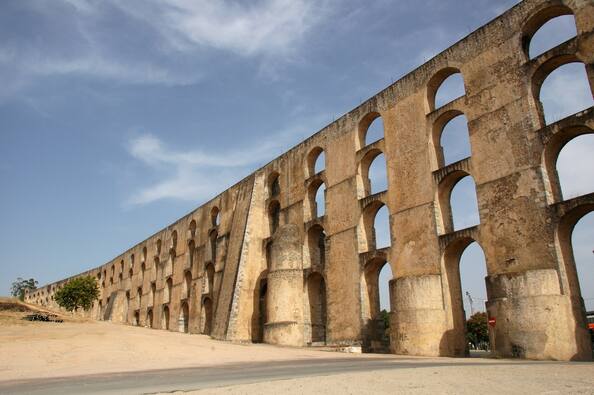国境防備の町エルヴァスとその要塞群
Garrison Border Town of Elvas and its Fortifications
The site, extensively fortified from the 17th to 19th centuries, represents the largest bulwarked dry-ditch system in the world. Within its walls, the town contains barracks and other military buildings as well as churches and monasteries. While Elvas contains remains dating back to the 10th century ad, its fortification began when Portugal regained independence in 1640. The fortifications designed by Dutch Jesuit padre Cosmander represent the best surviving example of the Dutch school of fortifications anywhere. The site also contains the Amoreira aqueduct, built to enable the stronghold to withstand lengthy sieges.
Description is available under license CC-BY-SA IGO 3.0
Ville de garnison frontalière d’Elvas et ses fortifications
Le site, fortifié de manière extensive entre le XVIIe et le XIXe siècle, représente le plus grand système défensif de remparts à douves sèches du monde. À l’intérieur de ses murs, la ville comprend de grandes casernes et d'autres bâtiments militaires, ainsi que des églises et des monastères. Alors qu'Elvas conserve des vestiges remontant au Xe siècle, ses fortifications remontent au moment de la restauration de l'indépendance du Portugal en 1640. Les fortifications, conçues par le père jésuite Cosmander, représentent le meilleur exemple conservé au monde de fortifications de l'école hollandaise. Le site comprend aussi l'aqueduc d'Amoreira, construit pour permettre de résister à un long siège.
Description is available under license CC-BY-SA IGO 3.0
Guarnición fronteriza y fortificaciones de la ciudad de Elvas
El sitio contiene fortificaciones de los siglos XVII a XIX. Se trata del mayor sistema de murallas y fosos secos del mundo. Dentro del recinto amurallado hay barracones y otros edificios militares así como iglesias y monasterios. Aunque Elvas tiene vestigios arqueológicos del siglo X, la construcción de sus fortificaciones comenzó con la independencia de Portugal, en 1640. Diseñadas por el jesuita holandés João Piscásio Cosmander, son el mejor ejemplo todavía existente de la escuela holandesa de fortificación en todo el mundo. El sitio incluye también el acueducto de Amoreira, construido para que la fortaleza soportara largos asedios sin carecer de agua.
source: UNESCO/CPE
Description is available under license CC-BY-SA IGO 3.0
国境防備の町エルヴァスとその要塞群
ポルトガルとスペインの国境付近にある、星型を組み入れた城塞都市及び近隣の星型要塞群。ポルトガルがスペインから独立を果たした17世紀から19世紀にかけて、近代的な築城技術を駆使して築かれたもので、空堀で防備された城塞としては世界最大規模。城塞内の市街地には教会や修道院のほか、兵舎や軍事施設などが残る。オランダ人が設計したこれらの要塞は、オランダ式要塞の最も優れた残存例であり、国境守備を担ったエルヴァスは、空堀の守備防塁システムを備えた顕著な例として重要な町である。source: NFUAJ
Garnizoensgrensstad en vestingwerken van Elvas
De garnizoensgrensstad van Elvas werd van de 17e tot de 19e eeuw zwaar versterkt en is het grootste verdedigingswerk met droge grachten ter wereld. Binnen de stadsmuren staan barakken en andere militaire gebouwen, kerken en kloosters. Er zijn in Elvas overblijfselen vanaf de 10e eeuw na Christus aanwezig. De versterking begon echter pas in 1640 toen Portugal zijn onafhankelijkheid van Spanje had teruggewonnen. De vestingwerken zijn ontworpen door de Nederlandse Jezuïtische pater Cosmander. Het is het best bewaarde voorbeeld ter wereld van de Nederlandse school van vestingwerken. Door het Amoreira aquaduct kon het bolwerk langdurige belegeringen weerstaan.
Source: unesco.nl
